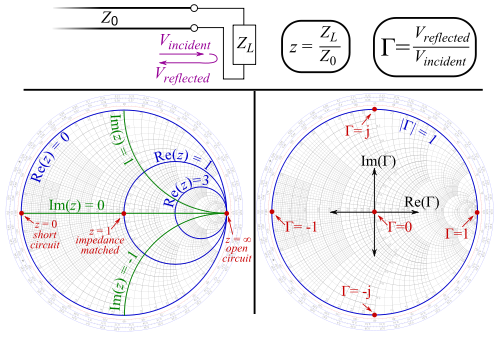

The Smith chart contains almost all possible impedances, real or imaginary, within one circle.
IMPEDANCE AND ADMITTANCE SMITH CHART HOW TO
What matters is knowing the basics and how to use them, like always. You can find books and articles describing how a Smith chart is a graphical representation of the transmission line equations and the mathematical reasons for the circles and arcs, but these things don't really matter when you need to get the job done. That's it! Transmission coefficient, which equals unity plus reflection coefficient, may also be plotted (see below). What is a Smith chart? It's really just a plot of complex reflection overlaid with an impedance and/or admittance grid referenced to a 1-ohm characteristic impedance. Some Smith chart links What's a Smith chart? Which way is up and where's that short circuit?
IMPEDANCE AND ADMITTANCE SMITH CHART PDF
If you want to download a Smith chart in pdf or gif format, we have several different ones in our download area!Ī clickable index to our Smith chart page: If anyone else wants to be a technical contributor on their favorite microwave subject, please contact us. We've got our own Smith chart tutorial here, thanks to a fan from Florida, Mike Weinstein, who really knows this subject, and is a fine writer too.

New for December 2018! The first year ECE students under the guidance of Dr S Raghavan, Professor, ECE dept., N I T Trichy, came out for the first time with the novel idea of putting a Smith chart on. They're promoting European Microwave Week 2020 in Utrecht (the Netherlands) with this Smith Chart template. Update August 2019: Here's a cool template that we got from Frank at TNO, a research organization based in the Netherlands that is known for GaN, SiGe and AESA work. You may notice from time to time that the Smith chart is used in the background on presentations at MTT-S venues. Richard Snyder participated in the negotiations with Ms. Smith sold the Copyright for the Smith Chart to the IEEE MTT Society in April 2015. The trademark on the Smith Chart recently expired, and Ms. Be sure to check out our entry on Philip Smith in our Microwave Hall of Fame! Phil's widow until recently operated Analog Instruments, the company that sold the official Smith chart for many, many years. The Smith chart was developed by Philip Smith at Bell Telephone's Radio Research Lab during the 1930s. Fritz Dellsperger was a Professor for RF and Microwave EngineeringĪt Bern University of Applied Sciences from 1992 to 2012, now retired.Click here to go to our main page on S-parametersĬlick here to go to a page on plotting Smith Charts with ExcelĬlick here page to learn about a three-dimensional Smith Chart The demoversion is limited to 5 datapoints and 5 elements. It allows elements to be cascaded between source and load. You can input s-parameters or use the keyboard or mouse to enter points and toggle impedance or admittance graphs on or off. On of my favorite tools for building and visualizing matching networks with the Smith Chart is at: Again, not being a software type, I may be way off base here and would appreciate feedback on this. Just use the saved picture of the chart as the "overlay" and all you need to compute / plot are the reflection coefficients. I am not a programmer and don't know if there is support for this in QT, but I have made use of this method in Excel. It seems a waste of processing to have to compute the chart impedance or admittance graphs every time the program is run. I would offer the idea of using a pre-calculated graphic overlay for the scales in the programs like NanoSaver.


 0 kommentar(er)
0 kommentar(er)
